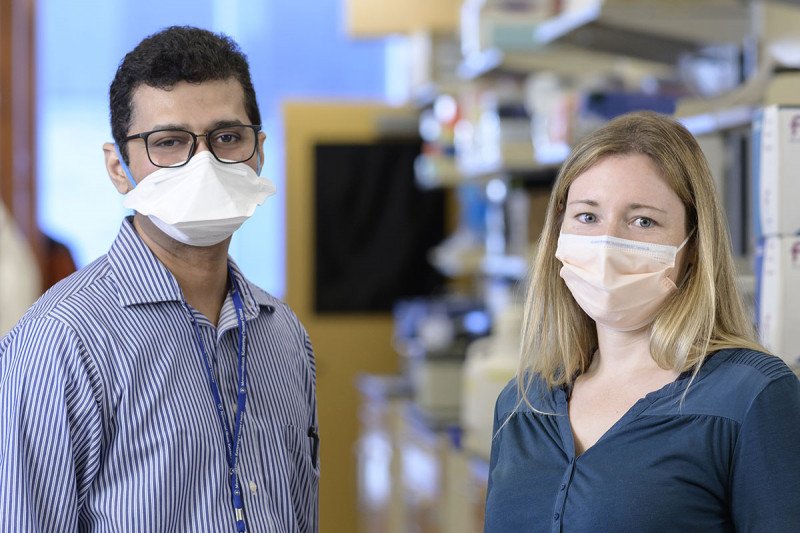
Geneticist Vijai Joseph (left) and molecular biologist Sabine Topka are studying how defects in DNA damage repair can lead to cancer.
Memorial Sloan Kettering scientists have discovered a new way to target a DNA damage repair pathway that could lead to a different kind of cancer drug.
Under normal circumstances, cells in the human body have several ways to repair their DNA if it becomes damaged. Cancer cells, however, often acquire changes that render them unable to efficiently repair DNA damage. In some patients, cancers are caused by inherited DNA repair gene mutations passed down from parent to child.
Understanding how cells fix broken DNA has led to the development of cancer-fighting therapies that take advantage of these defective repair mechanisms. These treatments include PARP inhibitor drugs, which treat cancers with flawed repair mechanisms caused by mutations in the genes BRCA1 and BRCA2.
In a study published in November 2020 in Clinical Cancer Research, MSK researchers reported findings on a DNA repair pathway called nucleotide excision repair (NER) and its role in the development of cancer. The paper also detailed how this defective pathway could be targeted, potentially leading to a new class of cancer drugs.
“The NER pathway hasn’t previously been looked at as a target for treatment,” says the study’s first author, Sabine Topka, a molecular biologist. “But we’ve found that mutations in this pathway are quite common, which suggests that finding drugs to take advantage of this defect is worth pursuing.”
Dr. Topka is the Associate Director of Laboratory Operations and Head of Functional Genomics in MSK’s Niehaus Center for Inherited Cancer Genomics, which focuses on the study of hereditary mechanisms of cancer predisposition.
According to geneticist and medical oncologist Kenneth Offit, “This is really an exciting story of functional genomics.” This field investigates how changes in gene sequence affect the behaviors of cells. “We started out with an inherited cancer gene, and now we’re looking at a new kind of targeted therapy,” adds Dr. Offit, who is the Director of the Niehaus Center and senior author of the paper.
A Gene Involved in a Surprising Number of Cancer Types
Vijai Joseph, an associate attending geneticist in the Niehaus Center, discovered the first clues that led them to the NER pathway in 2016. In a study published in Cancer Discovery that year, he and his colleagues reported that inherited mutations in a gene called ERCC3 were present in several families of Ashkenazi Jewish descent that had a family history of breast cancer without mutations in the BRCA genes. (BRCA1 and BRCA2 are the most common genes linked to breast cancer.) Researchers predicted that a drug called IlludinS, which was shown to be toxic to cells that lack ERCC3 or another related gene called ERCC2, would block tumor growth and kill cancer cells that harbor the newly discovered mutation. Dr. Topka then conducted experiments that confirmed this hypothesis.
In the new study, Dr. Topka and her colleagues wanted to figure out how often ERCC3 mutations are present in cancer more broadly. To do this, they reviewed data from MSK-IMPACTTM, the tumor-sequencing test that has now analyzed more than 50,000 tumors. Their analysis revealed that these mutations were present in almost 15% of bladder cancers, nearly 10% of uterine cancers, and between 5 and 10% of several other cancers, including pancreatic and prostate.
The next step was to find out how these mutations caused cancer to form. Dr. Topka used CRISPR gene editing to create cells with mutations in ERCC3 and ERCC2. She also put tumors with ERCC3 and ERCC2 mutations in mouse models and compared them to tumors that lacked these mutations.
Once the cells and the mouse models were developed, she tested several chemical compounds to see which ones might preferentially kill off the mutant tumor cells. She found that IlludinS, which is made from poisonous mushrooms, was the most effective killer of these tumor cells.
Further research confirmed that IlludinS kills cells by acting on the NER pathway. NER is a mechanism that repairs single-strand breaks in DNA; it is particularly important for repair breaks caused by UV light. The ERCC3 mutations appeared to be causing defects in this pathway.
Clues Point Toward a Potential New Class of Cancer Drugs
This understanding led to another discovery: an experimental chemotherapy drug called irofulven, which is based on IlludinS. Irofulven was studied in clinical trials in the early 2000s, including trials at MSK, but it was eventually abandoned because it worked on only a small percentage of patients and had a lot of side effects. In the new experiments, irofulven was very effective at killing cancer cells with ERCC3 and ERCC2 mutations in the test tube and in mice at relatively low doses.
The investigators are now working with chemists in the Sloan Kettering Institute to develop drugs similar to irofulven — which would also leverage NER defects to destroy cancer but have fewer side effects. “People have not yet developed drugs that work on the NER pathway,” says Dr. Joseph, a co-corresponding author on the paper. “Our goal is to find drugs that act on this mechanism but have less toxicity.”
They hope to advance a new drug into clinical trials. In the meantime, Dr. Offit says, it may be possible to treat people whose cancers have those NER mutations with irofulven.
Their research suggested that irofulven appears to work well in combination with PARP inhibitors.










